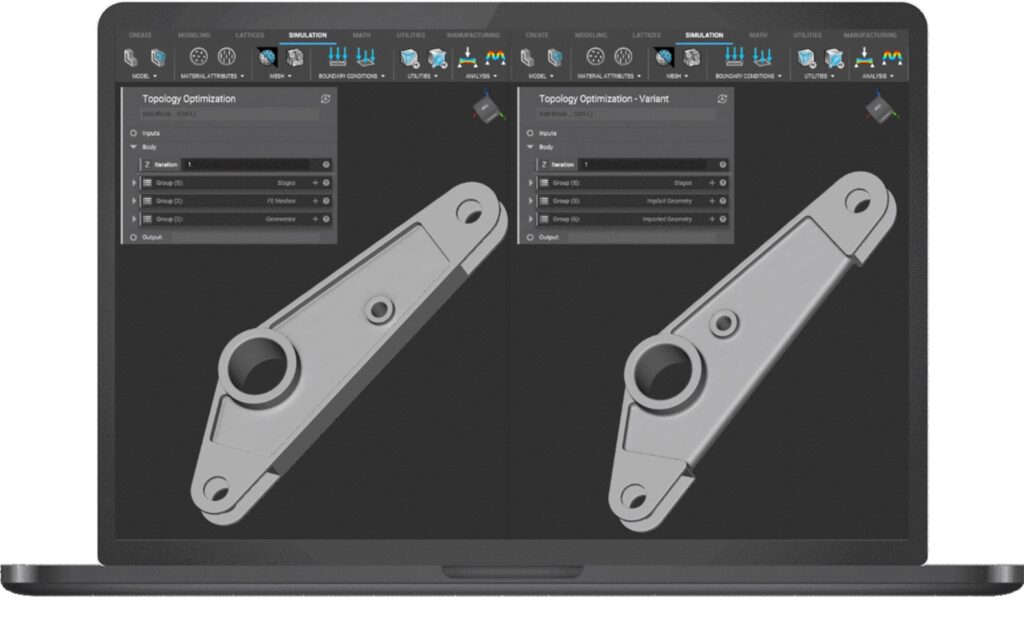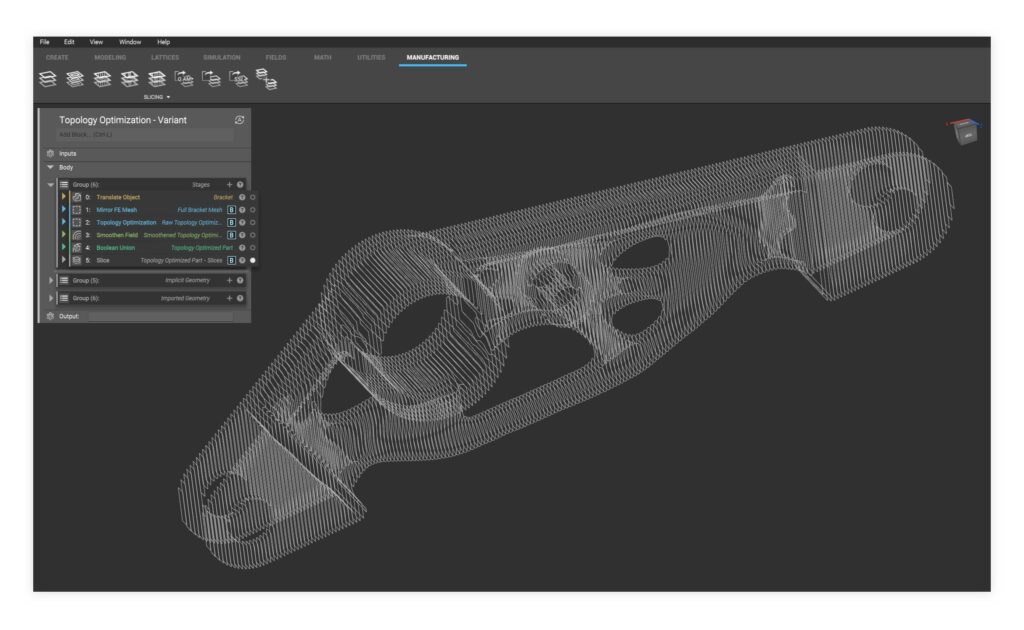Advanced modeling platforms enable engineers to produce the highest-performing parts in the shortest amount of time
In the world of advanced manufacturing, a project’s path from beginning to end never follows a straight line. Parts need to be designed, tested, and redesigned, often requiring multiple iterations before they can finally hit the manufacturing floor. As a result, the process can slow innovation and require extensive low-value work.
Design engineers know all too well that many frustrating obstacles typically emerge when attempting to resolve more complex designs. Though some pose as more of a showstopper than others, the biggest frustrations can include:
- Having to redesign an entire model after one small parameter has been modified
- Needing to utilize multiple software suites in order to complete a single idea-to-manufacture process
- Manually iterating input parameters for a desired output, such as changing the density of a lattice until a target volume reduction is achieved
Developers of advanced modeling platforms recognize that design-process issues such as these are quite commonplace when leveraging the power of new and evolving manufacturing systems such as additive manufacturing and precision CNC. By implementing the appropriate modeling platforms—and supplement legacy authoring software with the capability for intelligent, repeatable workflows–engineers can start eliminating productivity losses related to redundant and low-value tasks. The significance of repeatable workflows becomes even more evident as throughput of higher-performing parts increases in contrast to past projects of lesser scale.
Today’s reinvented modeling platforms enable engineers to leverage very complex geometries, quickly iterate on designs, and automate common but demanding operations. These sophisticated, new systems integrate with data from any existing CAD, simulation, or manufacturing software package, allowing engineers to efficiently streamline their workflows in a repeatable and reliable manner.
Engineers have long been in need of a way to capture and share knowledge that allows them to innovate more quickly and automate trivial modeling tasks. Design operations such as filleting the interface between a lattice and its adjacent shell often demand the full attention of the engineer to manually select every edge. With the repeatability and customization of a proven platform’s workflows, the process of blending these lattice beams to a structural solid can be developed once and leveraged endlessly.

A constant fillet radius of 0.5mm applied to each connection between the lattice and exterior shell
By utilizing a unique and easy-to-use block-based tree to perform complex modeling operations, connected workflows can be created, with broad design parameters that can be defined as controllable inputs. Not only does a nested system allow for configuration and packageability, it is automatically responsive to changes in upstream design parameters and external inputs.
The level of configurability the software provides enables the designer to create and distribute robust algorithms that are capable of automatically running numerous design iterations to converge on an objective-oriented result. Design exercises such as lightweighting through topology optimization or lattice propagation allows a user to define their solution upfront.

Topology-optimization workflow running through design iterations for a bracket and an updated model
The resultant complex geometry seen above can be exported as a classic surface mesh (STL) or sliced directly in the platform, avoiding the need for additional software before manufacturing. This, too, is an example of a type of common repeatable workflow that today is not streamlined in the stack of traditional engineering design tools. The most effective modeling platforms are architected to receive upstream changes and propagate them through the block system to produce a manufacture-ready model every time.

Optimized model ready to be 3D printed
A robust platform should include the ability to access prebuilt toolkits or configure repeatable workflows into toolkits that offer step-change advancements in the way engineers can collaborate across teams and organizations. The ability to lightweight components and generate complex geometries through rapid design iterations allows engineers to optimize part design faster than ever before.
By Sam Kratky, Application Engineer at nTopology.
Subscribe to Our Email Newsletter
Stay up-to-date on all the latest news from the 3D printing industry and receive information and offers from third party vendors.
You May Also Like
Stratasys Buys Arevo’s Carbon Fiber 3D Printing Assets
In its first major move since the year began, Stratasys Ltd. (Nasdaq: SSYS) has announced the acquisition of Arevo Inc.’s technology portfolio, marking a strategic expansion of its capabilities in...
Everything Must Go? Arevo’s 3D Printing Assets up for Auction
Arevo was among the first startups to develop a method for continuous carbon fiber 3D printing at large scales. With investments from Khosla Ventures and In-Q-Tel, among others, the Silicon...
Flexible Wireless Temperature Sensor Made with 3D Printing
Researchers from the University of Glasgow, University of Southampton, and Loughborough University have developed an innovative flexible temperature sensor utilizing microwaves and 3D printing technology. As detailed in an article...
3D Printing News Briefs, January 6, 2024: Digital Spares, Interbody Implants, Shoes, & More
In today’s 3D Printing News Briefs—the first of the new year!—we’ll start with metal 3D printing and move on to software and digital spares. Then it’s on to medical news...






























